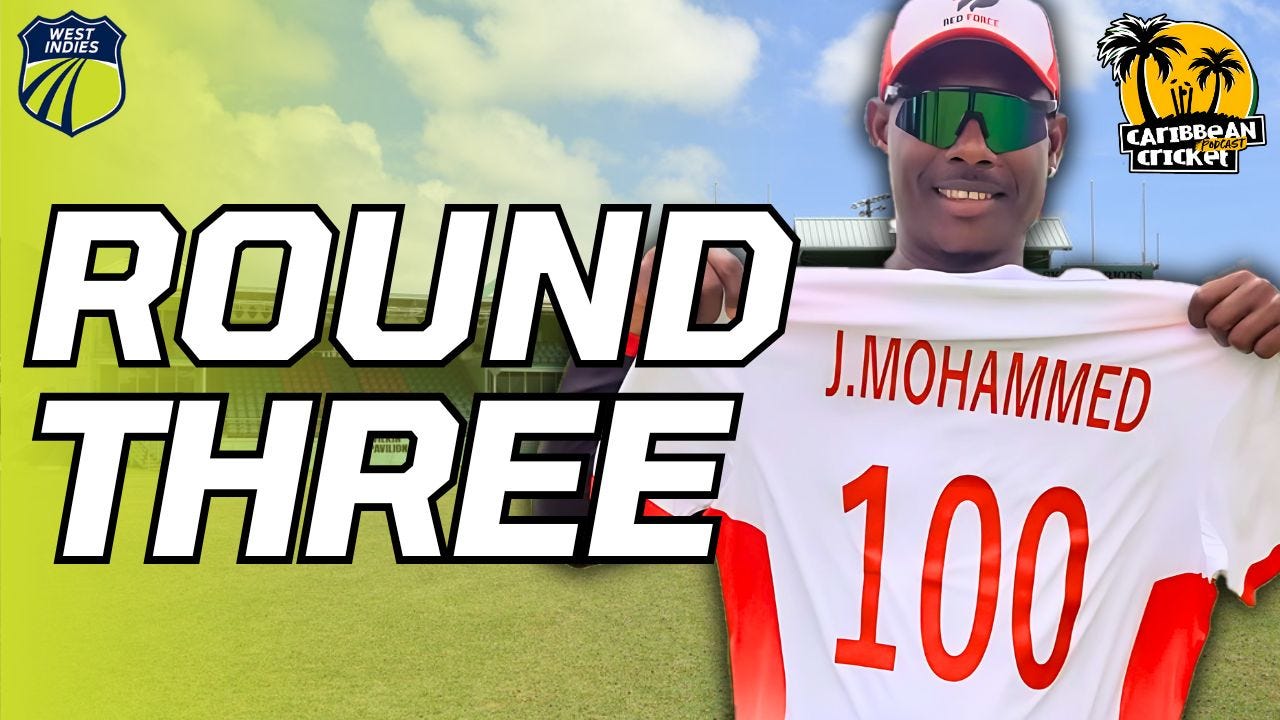As in seasons past West Indian spinners are dominating the highest wicket takers column in the regional four day championship.
Since the 2021/22 season, they have accounted for 73% of all dismissals in the top 10 list, while seamers have made up only 28% of the players included.
In 2022/23, seamers and pacers shared five spots each, whereas in 2023/24, only two, namely Jeremiah Louis and Anderson Phillip were included.
This year has not broken the mould, currently after three rounds, only one seamer finds himself in the top 10, that being Akeem Jordan, not playing for Barbados as he usually does, but for CCC, being their highest wicket taker by a long shot with 11 wickets at an average of 20 a piece, although not coming even close to Khary Pierre, with 27 wickets at an average of 8.7 each.
There are plenty reasons for the current state of affairs. Many might seem shallow or a poor attempt at scapegoating, but it might be useful for us to zoom into some of them for extra insight. If there’s a single truth about the ‘batting problem’ in the region, as described by Kieron Pollard, is that it goes a long way deeper than a single isolated issue.
The pitches
The quality of pitches for the Four-Day Championship, and even for international cricket, have been brought into question numerous times by a big array of different stakeholders in the region. Tony Cozier in an article 15 years ago aptly named ‘The pitch is the problem’, describes the pitch quality as ‘clear in the utter dominance of ordinary spin bowlers in the regional first-class tournament and the technical deficiencies of batsmen.’ Even more than a decade later, this phrase would clearly fit in our current conundrum.
Situations that would be considered scandalous for other cricketing nations are, more often than not, a disappointingly common occasion that shows where we really stand. No two cases would represent this better than in the first round of the 2023/24 season, where in Spanish Town, Barbados, in a match against CC&C, the first day was abandoned due to a leakage in the outfield, the scenes of groundsmen digging up a big hole in the middle of the field stay in recent memory.
At the Conaree ground in Basseterre, Saint Kitts, a very infamous case on the second day of the T&T and Guyana match, allegedly happened, where the groundskeepers forgot the gates open and, overnight, cows trampled the field. True or not, whatever occurred play was not possible for the next 3 days.
Of course, such outlandish stories are not necessarily common but, overall, problems like patchy outfields, uneven pitches after a couple sessions in, grass not properly trimmed, drainage problems and more are common. Groundsman quality is also an issue, lacking a high level of preparation and knowledge required to prepare and upkeep these tricky 22 yards. An article by Sportstar in 2024 features an interview with Kent Crafton, the central curator for the region, where he lays out the problem, ‘Roughly 70–80% of a good pitch lies in its upkeep. Without proper maintenance, even the most meticulous preparation yields subpar results.’
As much as one might point to these as being the centre point of the batting crisis, it wouldn’t be unreasonable to say that the situation finds itself in a better position than in previous years. During the preparation for the T20 World Cup in 2024, many of the pitches were relayed, roller sizes were standardised and a workshop for curators and grounds staff was implemented for more than 100 participants across the Caribbean, as pointed in the CWI article ‘curators and grounds staff workshop reaps benefits ahead of T20 World Cup’.
The numbers would show some support of the betterment of the pitches, if only slightly. In the 2021/22 and 2022/23 seasons, there were only 6 scores above 400, in the current season alone after only three rounds the same amount of 400 plus scores have been scored, with the 2023/24 season having six scores above that mark as well. One could fairly point out that those are mostly 1st innings scores, and more than frequently, teams are not able to score more than one 300 plus total in a match. For as valid as that criticism is, the surfaces and outfields have been showing improvement, albeit small, since the previously hosted World Cup.
Match amount
Perhaps the most dramatic change for casual viewers, starting from the end of the 2019/20 season, was the change from the previous 10-match season, starting in December and finishing in April, to the now seven match standard since the 2023/24 season, with the lowest being in the 2022 and 2023 seasons, with only five matches being played in total.
By all means the culprit is clear: Covid-19, the last two rounds of the 2019/20 season were abruptly cancelled due to the first cases of the disease being reported in the Caribbean. Still in 2020/21 there would be no cricket, as Johnny Grave, now former CEO, as pointed in an article to the Daily Express: ‘The complexities are around Covid-19 protocols in terms of quarantine on arrival and on re-entry to home territories.’
For the start of the 2024 season, and still in motion today, were the additions of two developmental teams: the West Indies Academy (WIA) and the Combined Campus and Colleges (CCC), increasing the number of matches to seven. The inclusion of these teams, however, has been brought into question a number of times, with CCC losing all their matches in 2024, and not a single win to date, the academy with only three wins so far since they were introduced.
The quality of their bowling and batting is understandably developmental, and with the new generation of the WIA looking weaker without Kadeem Alleyne, who is not playing FC cricket currently and last played in the BPL, and Joshua James who is currently playing for Trinidad.
It is currently not clear the reasons for the shorter seasons. One might speculate that it has to do with finances; until the end of this FTP cycle, no matches against India or England in the Caribbean are scheduled, and plentiful are the away tours to India, South Africa and New Zealand. Even then, CWI in their 2023 financial report, showed a positive net equity of $25.7 million dollars, with a big surplus expected for the 2024 financial year due to the World Cup revenue, and white ball tours by India and England respectively. As we await the 2024 Annual Report it would be fair to ask if there are not any plans for a comeback to the 10-match double-robin format of previous seasons.
With all of that taken into account, the number of matches doesn’t necessarily correlate with either bowling or batting quality. Spinners still dominated the longer seasons, and no number of matches, or extra experience showed any reasonable difference to shorter seasons. A larger sample size of games is useful to properly analyse players, to see if they are able to show consistency for a long period of time, but it does not solve the primary problem: technique and coaching.
Technique and coaching
Problems relating to the internal structure of CWI are nothing new, from the days of Dave Cameron and his autocratic rule, firing Phil Simmons one of the few high-profile coaches of the region, due to him speaking openly about meddling of the board into the selection process; the worsening of relations with star T20 players and the mishandling of the revenue. The situation has vastly improved in recent years, with more aspects of the Wehby Report finally being implemented after almost 5 years since its inception. That in mind, results on the field have been questionable, in turn because the problems run deeper, going back to the grassroots level.
A quick glance at regional emerging competitions, and domestic interschool championships throughout the region, should highlight how poor the infrastructure, pitches and materials are. In the 2024 U19 2-Day Rising Stars Championship, out of the 34 innings played, there were only seven scores above 200, with 47% of the innings below 100 runs; for the U17 matches it’s even worse. The quality of the pitches is sub-par, with so many patches and deterioration after a couple dozen overs, with the ball seaming and spinning with minimal effort. Shot selection is another big problem, batters stuck to their creases, few if any footwork, robotically playing shots with no game context, not knowing where their off and middle stumps are and a clear lack of patience and discipline.
It is no wonder then, that Azim Bassarath, now vice-president of CWI, said at the CARICOM Regional Conference: ‘I think that we have to start from the grassroots level to take our cricket forward. We cannot start at the top now, we have to start at the grassroots, […] It is coaching programmes. Going into the schools, going into the communities, assign coaches to the different grounds across the territory.’ Beyond the CWI Emerging Players Academy in Antigua, and a new one being planned for the women, so far, no announcements have been made for the improvement of pitches for the youth games, or grass roots coaching initiatives.
These basic technique and coaching failures don’t only stay isolated at the lower levels, but spread to the highest grades of senior competitions. For a clearer picture, we’ll analyse the performance of Yannic Cariah and his bowling figures of 34-3-103-5 against the Leeward Islands in the 3rd round of this year’s Championship. Here’s the raw data:
T&T only bowled once so these are also his game figures. The match was played at Warner Park in Saint Kitts, famous ground for their flat wickets and short boundaries, for this case it was not different. Even though there was minimal turn from the track, with most balls coming at a reasonable height, all the wickets in this innings came from spinners: Pierre and Cariah with a fifer each. These two exemplify all that is needed for someone to be a successful spinner in the 4-Day Championship.
In Cariah’s first spell he bowled 12 on the trot, introduced early in the 14th over with not a lot of spin and bounce on offer, he consistently placed the ball on a 5th stump line, bowling around 70% of his deliveries in that general area. Without a convincing wrong’un, for most of the first spell he didn’t particularly trouble Kadeem Henry and Mikyle Louis, who showed remarkable patience when dealing with him. The tactic was simple, if it’s outside of the stumps, leave it, if it’s full on, defend it, if it happens to be short and straight, you might want to push it to the leg side.
In his second spell, coming back in the 73rd over, is when we saw the real core of the problem. From bowling 70% of his deliveries on the off side, it was 50/50 with the balls aiming straight at the stumps, with surface more worked over, spin and bounce became plentiful.
Bowling a leg breaker around middle and off stump, giving it a decent amount of flight and revolutions on the ball for it to turn and to either, get the top of off, or get the ball back to the keeper. Even though he missed his line a couple times, bowling too full with some level of frequency, no batsman dared to come down the wicket to face him straight on and punish the bad ones.
Eventually, with one major exception, the batsman fell under the pressure of a decently rigid line and length, and got out playing poorly executed shots. Hayden Walsh was the highlight and exemplifies the situation.
Cariah bowls over the wicket to the left-hander, the balls lands around the 8th stump line, back of a length, turns back into the on-side, would miss the leg stump by possible a yard, but Walsh goes down on his knees, doesn’t move an inch from where he was standing, plays a reverse sweep perfectly aimed at 1st slip, and he’s out.
From this, it should be no coincidence that, out of the nine spinners in the top 10 wicket takers this year in the Championship so far, seven of them turn the ball away from the right hander. Another characteristic they have all in common is flight, the balls stay in the air for long periods of time, ensuring more turn by all means, but sacrificing almost all of the ball’s momentum. The question is, why?
It boils down to a single, and deeply saddening truth: all current batsmen in the region are technically flawed. This of course comes from the heritage of a subpar grassroots development stage, but it also has another layer, complacency. If everyone gets out in the same way, why attempt to change your technique? If the way I bowl gets consistent wickets, what does it matter what would be effective in the international stage, if I am successful? There is no bigger task than to raise above mediocrity.
What are the current technical failures against spin bowling? This stat should make it a big one: in the 207 deliveries Cariah bowled in that innings, not once, did a batsman come down the wicket to face him up.
These were not academy boys mind you, but a senior Leewards side. Another problem, not being able to read from the seam position, point of release and wrist position, making every ball guess work, and making 22% of all shots against Cariah completely not in control.
If you don’t have any footwork, you can’t get to the pitch of the ball, getting stuck on your crease and aren’t able to score from most good length deliveries. Not having the ability to read deliveries traps you into playing false shots and never feeling at ease. When the ball moves away from the batter, it becomes necessary to quite literally take the first step, to get in position to hit the ball; it becomes clear that very few batters in the current domestic setup are willing to take the first step.
Thank you to Luis Granada for his debut article for the Caribbean Cricket Podcast substack.
The Caribbean Cricket Podcast is on Facebook and of course you can also find us on X and Instagram and all other social media platforms.
If you'd like to support the Caribbean Cricket Podcast you can become a patron for as little as £1/$1 a month - Here
You can buy the brand new Caribbean Cricket Podcast beanies now - please get in touch if you are interested in getting one.
You can also find out more about Caribbean Cricket Podcast at www.caribbeancricketpodcast.com








Very insightful article and on point!
Amazing article! Congratulations!!!